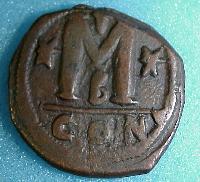   |
A Byzantine Follis
The copper follis, introduced by the Emperor Anastasius I in 498 was the workhorse of Byzantine coins during the reign of Justinian I.
According to Philip Grierson (Byzantine Coinage, 1999 Dunbarton Oaks) The largest denomination of the period was the gold nomisma (solidus in Latin) which was worth around 11,520 of the smallest denomination, the copper nummus. The follis, the largest of the copper coins was worth 40 nummi or 1/288 of a nomisma.(This is approximate since the actual weight and hence the relative values of coins fluctuated at different times) You will often see a reference to a bronze follis, but this can be misleading because the Romans used the term bronze to refer to metals other than gold.
Silver coins were not minted, perhaps because the value of silver fluctuated so widely. Thus, there was a large gap in value between the follis and the three gold coins, the nomisma the semissis (one-half nomisa) and tremissis (one third nomisma).
The Byzantines of the sixth century used three other copper coins, in addition to the follis and the nummus: a half follis, a decanummium (one quarter of a follis) and a pentanummium (one eighth of a follis).
The follis wasn't worth very much. Professor Robert Gurval of UCLA points out that the Codex Theodosianus, for example (363 CE) listed 1 lb. of pork as 6 folles and in the fourth century. St. Augustine (Sermones 389, 3) said that whenever a certain man sold a solidus, he gave two folles to the poor,which would have been a very small amount.
Our particular follis would appear to be from the earlier part (527-537)of Justinian's reign (527-565) because the Emperor, although no longer a realistic likeness as had been the case with earlier Roman coins, is depicted in the traditional profile which Justinian would change to a front facing view in 538/39. Dates were also added to the coins at this time. (ONE FOR SORROW is set in 535 so John might have handled this coin himself).
You can make out preceding the emperor's name (IVSTINIANVS) the letters DN (Latin, "Dominus Noster," for "Our Lord") and after the letters PP ("perpetuus'or "eternal") and a hint of the worn AVG , the abbreviation of AVGVSTVS. So the inscription, in its entirety, was "Our Lord Justinian Eternal Augustus.
The M on the obverse is Greek for 40, since the follis was worth 40 nummi. During this period Latin had not yet given way entirely to Greek, with both languages still being used, Latin for some official matters and of course in the church. The CON beneath the M is the mint mark, showing that the coin was minted at Constantinople, just one of various mints scattered around the empire.
 |
|
|